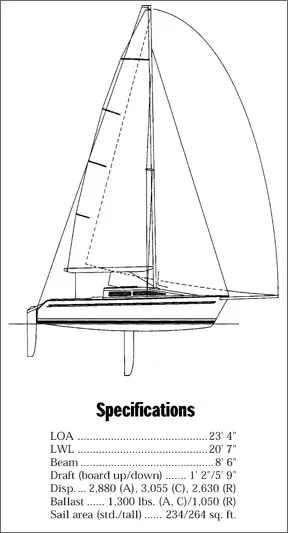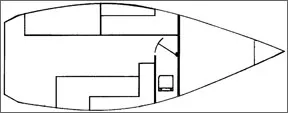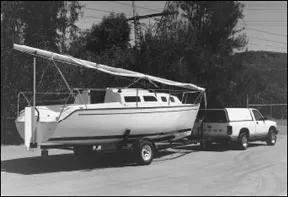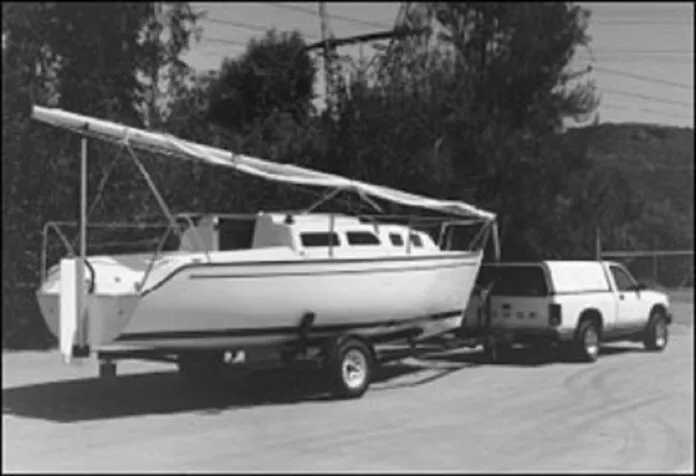With the introduction two years ago of the Santana 2023, one of the newer waterballasted trailerables, the W.D. Schock Corp. in Southern California offered entry-level sailors the same types of mix-and-match options available at an automobile showroom.

The A model is your basic family sloop with a contemporary, low-profile cabin. The 2023 C (cruise) has a longer trunk cabin with more amenities below. The 2023 R (race) is optimized for performance with a sprit for flying asymmetrical spinnakers, though you can add a tall mast to either the A or C model. The R model has the same cabin top as the A model, which we think is more attractive, but has less headroom below, of course.
Air conditioning and white wall tires? Well, thats a stretch.
The Builder
The versatility of the companys product line comes as no surprise, considering that during slow-downs in the boatbuilding business during the mid-1940s, founder Bill Schock kept the doors open by repairing woody station wagons and building furniture, including wooden toilet seats.
Schocks entry into boatbuilding was unplanned. He built his first boat at age 11, but at 26 was running a pontoon repair business. Intrigued by the design of the International 14, he ordered a kit. Before long he had orders for three boats and the rest, as they say, is history. By the early 1950s, his fledgling company was on firmer ground with the construction of I-14s, Sabots and Thistles.
Bill Schock may be best remembered, however, for purchasing designer Barney Lehmans company and building one of the first production fiberglass boats, a 10′ sailing dinghy called the Lehman Interclub, which sold for $642. He was subsequently certified to build the first fiberglass Thistles, International 110s, Penguins and El Toros. Schock claims to be the oldest production boatbuilding company in the country with more than 25,000 boats produced.
In 1959, he converted a homely, under-performing 14-foot cat boat to a centerboarder with headsails and the Lido was born. The company has since produced more than 5,000 of these popular little daysailers, and commemorated its 50th anniversary with the introduction of a special edition at this years Sail Expo.
The companys first venture into the cruising market came with production of the Schock 22, a Calkins-designed version of a Highlander to which were added a small cabin, bunks for four and a hinged mast. Schock proclaimed the boat to be the first trailerable ocean racer in the country, and proved his point by sailing it on extended cruises.
Following in his fathers footsteps, son Tom began sailing as a tyke and by age 12 had become the youngest winner of the Snowbird regional championships. By the mid-1960s he was well entrenched in the business and had developed a reputation on the racing circuit that resulted in an invitation to sail aboard Columbiaduring the Americas Cup trials. Tom now is president of W.D. Schock.
After crossing paths with architect Gary Mull at a West Coast regatta, the two formulated plans for construction of the Santana 22, a spacious, fixed-keel, sloop-rigged cruiser designed to perform competitively around the buoys and on the MORC circuit. More than 700 of the 22s were produced; active one-design racing fleets are scattered across the country.
The 2023 is a development of the Santana 23 (same hull), designed by Shad Turner and introduced in 1979. But the 2023 is a fractionally rigged, water-ballasted center-boarder that is significantly lighter than its predecessor, and is easily trailered by the family car. About 170 have been built.
Design
Steve Schock, Toms brother, completed the design work for the 2023. Its fine entry, straight sheerline, and reverse transom are, to our eye at least, attractive. Though the 2023 is a contemporary design, it is not as plumb-bowed as some other new designs, but does have a self-bailing open transom. With the centerboard up, it draws just 14″ for trailering and gunkholing. The low cabin and long, black ports of the A and R models are sleeker in appearance than the more traditionally designed C model, which has a higher doghouse and four portlights.
Below the waterline, the A and C versions have conventionally designed appendages, while the rudder and keel of the R version are elliptical shapes designed to improve upwind performance and tacking ability. The kick-up rudder on the A and C models is mounted on a rudder post in the cockpit sole, and controlled with lines in the cockpit. This makes it essentially an inboard rudder, though it folds up out of the water and against the transom because the post is located well aft. The outboard R version rudder is mounted on pintles on the transom. One C-version owner retrofitted an R rudder after a launch mishap. He said the change improved the boats pointing ability, as well as making for crisper tacking.
The spar on the A and C models is a lightweight section constructed in the Schock factory. The spreaders, which are swept back 20 degrees, are supported by 1 x 19 wire attached to the mast with a ball and socket joint. Schock said that in addition to permitting a larger mainsail roach, elimination of the backstay reduces weight aloft by 3 pounds. Cruisers sailing in areas where winds are light may choose an optional rig that is 3′ taller.

The standard rig would seem to be designed to make raising and lowering as easy as possible; however, without a backstay it wont be possible to fully tension the forestay. There are single lower shrouds (in addition to the uppers), which lead to chainplates at the edge of the cabin top.
The A and C reefing system for the mainsail is a boom furling arrangement, managed by rotating a hand crank while easing the main halyard, a feature much appreciated by a number of owners we talked to. All had experience sailing in breezes of more than 15 knots, and one described sailing in 30 knots on a choppy day in San Diego. Each said that the reefing and furling gear facilitates easy reductions in sail area.
The R version mast, a taller, tapered section manufactured by Sparcraft, has a conventional backstay, since support is necessary for the masthead spinnakers.
Spreaders are only swept back seven degrees.
One owner encountered a problem with the failure of welds in the spreader bar, a fitting inside the mast to which the spreaders are attached.
Tom Schock said, The problem was that we were cutting and welding two sections to the mast and we suspect that the welds were failing from vibrations when being trailered.
To solve that problem, the spreader bar is now a single piece of aluminum bent to the proper angle and heat treated.
Headsails for all models are attached to a Harken roller furler. Jib sheets on the C-version lead aft through a turning block to cam cleats on the coachroof. Two owners replaced the cleats with Lewmar #16 winches, an option Schock feels is unnecessary because of low loads. Genoa track is standard on the R version.
The mainsheet on the A and C versions is attached at the end of the boom and led directly to a wire pennant secured at the stern with stainless fasteners and a backing plate, then forward to a padeye in the cockpit and a Harken cam cleat. A factory option to the pennant arrangement was an aluminum barney post to which the sheet lead was attached with screws. Several gear failures were reported by owners of C models when the sheet tore the fitting free of the post.
We drilled holes 1/32 too large for the fasteners we were using at the factory, Schock said, and didnt realize we had a problem until the first failure. Then we realized that, since we produce several boats at a time, we had several problems. Retrofits were made by the factory.
The R-version mainsheet is led to a traveler on the cockpit sole, which improves sheeting angles and sail trim, but impairs movement about the cockpit-an old bugaboo.
Cockpits in both versions are spacious, though the 8′ long R version, 2′ longer than the C-model, provides more room and improves maneuverability for racing crews. All models have cockpit lazarettes large enough for fuel tanks and modest amounts of gear.
Interior
Considering the overall length of the boat, accommodations belowdecks are spacious, due in part to the 8′ 6″ beam. The A and C versions have 6′ settees with 3″ foam cushions. A tiny plastic sink and counter are mounted on a starboard bulkhead, below which is a shelf providing space for a single burner alcohol stove. A compartment below the counter houses an ice chest mounted on slides.
Forward of the bulkhead is an enclosed head with a portable toilet, and a 7′ long V-berth.
The portside quarterberth is 6′ 4″ long and 27″ wide.
There is a storage area below the cockpit. A poptop increases standing headroom to more than 6′. The portable dining table can also be mounted in the cockpit.
One owner replaced the plastic sink with a stainless model, and installed a water pump. He also removed the ice chest and converted the area to storage.
Two owners were dissatisfied with the latch on the door of the head, a single wood section with a tendency to open when heeled to port. One removed the door entirely and replaced it with a curtain; another made a bi-fold door and reattached it with brass hinges and latches.

On a more positive note, all owners said they liked the boats livability. All had cruised for extended periods on lakes in Nevada, on the Sea of Cortez, in blustery conditions in San Francisco Bay, and Puget Sound.
Because of its longer cockpit, space below in the R version is reduced. Port and starboard seats form a dinette just aft of the V-berth. A second double berth is located underneath the cockpit. The enclosed head is amidships, across from the galley sink. For racing, this layout places the weight centrally. But cruisers will find the V-berth cramped. Because the retractable sprit is housed to starboard belowdecks, it intrudes into the sitting area on the starboard settee and presents a rather uncomfortable backrest. The sprit is housed in a fiberglass tube that runs through two bulkheads. A tiny plastic hose attached to the aft end of the pole and led to a sink drain on the other prevents the intrusion of water into the cabin.
Construction
The 2023C is constructed of hand-laid fiberglass. After 18-20 mils of gelcoat are applied to the mold, two layers of 1.5-ounce mat and a layer of 18-ounce woven roving are bonded using polyester resins, with extra layers added at the keel trunk. Hull thickness is 1/2″ on the bottom and 3/16″ at the sheer. The deck is a similar combination of mat and cloth cored with marine plywood.
The deck overlaps the hull by approximately 1″, and is bonded with 3M 5200 to a 1″ x 1″ beam running the length of the hull and finished with stainless steel fasteners on 8″ centers. A plastic rubrail covers the joint.
Because minimizing weight is critical to racers, the R model is constructed with 1/2″ Divinicell core in the hull and deck. The combination of a lighter mast and hull and fewer amenities belowdeck allows the R model to weigh about 250 pounds less than the C.
Exterior surfaces on the boats we inspected were nicely finished and detailed, deck layouts were proper for each boats intended use, and high quality rigging and hardware was used.
However, the interior does not reflect the same attention to detail. Surfaces are painted white and are textured. Wood surfaces, counters and bulkheads are teak or veneer. Upon close inspection, we discovered that corners werent joined or trimmed properly, some edges were not finished smoothly, and head doors were not plumb. The overall impression is that finish work would benefit from closer scrutiny at the factory.
One owner purchased a 2023 in 1993 and has been attempting to resolve warranty issues for almost two years. He experienced the broken spreader problem mentioned earlier. His companionway ladder delaminated. The clew ripped out of his jib. He discovered voids in the gelcoat, above the waterline. Most importantly, his gelcoat has faded and blistered, and he has been unable to resolve the issue with the factory.
Tom Schock acknowledged the most serious issues with this unhappy customer, including his personal failure to resolve the issue more expeditiously.
The air voids are uncommon, not representative of our product. We have been attempting to resolve the gelcoat problem with the manufacturer, but so far the manufacturer has offered no help. An immediate response was made by the gelcoat manufacturer by adding more UV retardant. Unfortunately, our customer has suffered a delay in the process, and I have been negligent in not solving the problem more quickly. Doing that will be a New Years resolution, he told us.
Performance
We sailed an R model in moderate breezes on a lake, and were impressed with the boats performance. An 8-hp. outboard with a long shaft moves the boat well, though the factory specification is only for 6-hp. Hoisting the main and unfurling the jib were straightforward, and the boat moved towards hull speed and 15 degrees of heel in 6-8 knots of wind. It is nicely balanced, and appears to sail to within 30 degrees of apparent wind. The weight of a railbird will be advisable when heel is more than 15 degrees.
Setting the asymmetrical spinnaker was a simple matter of pulling a line to extend the bowsprit to its 5′ length, and pulling the halyard, which is led to a cleat in the cockpit. As we have experienced on other sprit boats, the 2023 performs best when sailed at high jibe angles; it is appreciably slower when sailed below 140 degrees of apparent wind. It rewards good driving and sail trim with the sensation of speed and the occasional spurt forward in a puff. Jibing is an uncomplicated process as long as the spinnaker sheet is eased before the boat turns, thus avoiding the potential for a wrap around the headstay. Under spinnaker, the 2023 R seems much more forgiving than the hot rod sprit boats designed specifically for the race course.
Trailerability
Because the sails are attached to the boom and headstay inside a protective sock, shrouds are attached to chainplates, and there is no backstay, the C model is easily rigged by two experienced people, ready to launch in about 15 minutes. Optional equipment includes a hoisting pole, which we think may be unnecessary considering the light weight of the mast and boom. When being trailered, the mast is supported by an aluminum crutch in the cockpit and on the bow pulpit.
The boat fits nicely on a Zieman trailer with a long cradle designed specifically for the 2023. Owners say that filling and draining the ballast is as simple as opening a valve and the air vent located on the cabin sole. Then you wait for 1,300 pounds of water (1,050 for the R model) to enter or run out of the tank.
Dry weight of the boat and trailer is 2,080 pounds without gear. As we have noted on the MacGregor 26 and Catalina 250, the water doesn’t drain until the hull is out of the water, so even though a suitable mid- or full-size car might tow the empty boat, the car will work hard to get the boat up the ramp.
Conclusion
We think the Santana 2023 is a reasonable introduction to cruising lakes and protected waters. Its simple operation should not confound beginners or those stepping up from daysailing. Though the design of the 2023 is not as radical or sophisticated as other sprit boats such as the Melges 24 or Ultimate 20, the hull is well designed. It is easy to rig and launch. While early models suffered gear failures, Schock appears to be working out the bugs. Still, we are dismayed that at least one customers warranty work has not been completed.
At the time of our 1996 review, the prices were $14,175 for the A model. The C model listed for $16,275, the R model for $20,475.
If we were ordering one, wed take the A model (we like the long cockpit and much prefer the looks of the low-profile cabin to the trunk cabin of the C model) and buy the optional taller mast to improve performance.



































